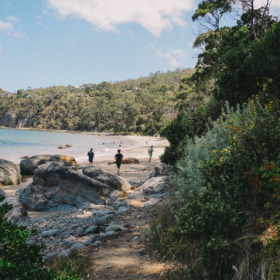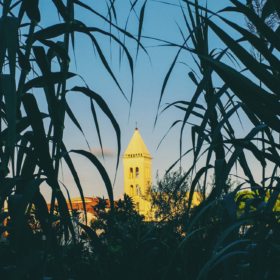I’m embarrassed to admit I knew very little of Berlin’s history before we visited Germany. I actually wasn’t even sure what the significance of the Berlin Wall was. I’ve never taken a history lesson, and what little we were taught in our compulsory SOSE classes at school usually related to Australian or American history. I’ve always had a similar outlook as my mother, that what we don’t know can’t hurt us. It breaks my heart learning of wars, hurt, pain, oppression, terrible things that happened that I can’t do anything to fix. So one of my main priorities in Berlin was to learn more about the city, its people and their history.
We started by watching documentaries to better understand what the purpose of the Berlin Wall was before we made our way out to see it’s remains. In the few hours of watching youtube documentaries I was horrified to learn what the Berlin Wall meant. That basically this wall was built to physically divide a city and lock people away from choosing how they want to live. That families were sepereated by this concrete structure, people were locked out of their jobs, lives and dreams. People died trying to escape. This inhuman event actually happened.
There are two different sections of the remaining Berlin Wall that we visited. Firstly we started at the sombre Berlin Wall Memorial on Bernauer Strasse. For a few kilometres we wandered along the remains of the Wall and the death strip, reading information printed on plaques, detailing stories of those who lost their lives and gazing on pictures printed metres high on buildings. It’s harrowing, confronting and emotional. It’s all the reasons I avoid learning about our history. My heart was broken but I also left feeling proud learning of those who stood up to the oppression and who fought for their freedom.



The second section of the remaining Wall we visited much later when we were spending a day of exploring with my dear friend Aislin. The East Side gallery is a section of the Berlin Wall that has murals painted by street artists from all over the world. The vibe here is very different to the memorial. Tourists wander down the street in hoards and there isn’t much room on the footpath. It was a bizarre contrast to the emotional journey I felt a week earlier. I gazed at the paint spattered concrete and underneath all the joy and colour I could still feel the horror it represented, but also the rebellion. That something built to stop a group of people from expressing themselves had been turned the ultimate form of expression.



My next Berlin history lesson came in the form of a free walking tour. There are several great walking tours that operate in Berlin for tourists (and even some locals come along too!). Some are paid walks with a specific price, and others are ‘free’ walks that are tip based meaning that at the end of the walk you tip your guide however much you can afford or think the walk was worth.
My first Berlin walking tour was the Alternative Berlin free walk that covers street art, some alternative history, squats and other stories. I met up with lovely Leah who caught a bus to Berlin so we could spend the day exploring together. After a morning spent rummaging at Mauerpark Flea Market we met the walking tour at Alexander Platz and spent the next three hours learning about the alternative history of Berlin.




Our guide was wonderful, telling us about the local street art, showing us some of the oldest squats in the city and slipping in small stories about the cities history. My favourite was that of the Berlin Tree House on the Wall. The story of Osman Kalin, who while the Berlin Wall was still standing in 1983, decided to build a house from junk materials on a small strip of forgotten land that lay directly beside the Wall. The land was officially owned by the East, but by chance the Wall had been constructed to follow the curvature of the road, meaning that this small piece of forgotten land had ended up on the Western side. The Eastern guards were suspicious when he began building his structure, but decided to let the Tree House stay as they hoped that those living in the East would see the misshapen house and think that the West Berliners were living in those kinds of conditions.
When the Wall fell in 1989, locals helped to rally support to save Osman’s home from demolition. To this day, the property still remains and Osman who is now into his 90’s still calls the Tree House home.

For our second Berlin Walking tour, Martin and I went along on The Third Reich walk, which is a paid walk but it was incredibly educational. It follows the history of the Nazi regime in Berlin, outlining Hitlers rise and fall, the destruction he left in his wake, his dreams of Germania the Nazi super city, the remaining Nazi buildings in Berlin and the extensive memorials left as tribute to those who suffered.



For someone who has never put in the effort to learn about our world history.. this walk was a real wake up call for me. I couldn’t block my ears to the stories of corruption, death, torture and rape. I always knew that the Nazi’s were evil and corrupt, but learning how ridiculously they chose their victims, that a man so obviously insane was able to have that much power shocked me. No one was spared, not even the sick, disabled or children. I’m not going to pretend I didn’t finish this walk with a deep hatred for the men that caused these wars. Men who killed for no reason, how the ‘good’ guys even raped and murdered. Everyone loses in War.

Even after learning of the inhuman history, I found a deep sense of respect for this city. They do not hide from the darkness of their past, but instead there is an echo of ‘we must never forget’. Murals and memorials are dotted throughout the city. Nothing is hidden or forgotten. Just walking down a suburban street you might happen upon a hold plaque cemented into the pavement, with the names of those who lived and died as a result of the wars and destruction. I learned a lot from Berlin.
I’m grateful we chose to take ourselves on this journey of learning a little about Berlin’s past, it really helped me to understand the complexity of the city. I would have disappointed myself to simply take Berlin on face value. Now I feel like I understand the brokeness, the need for rebellion, the souls who are patching the cracks with love and a new found spirit.







Alice
I studied so much history in my life, instead, that sometimes it’s overwhelming, just thinking of going to visit a place you’ve read so much about.
Well done, you searched for infos and really tried to understand, and that’s more important than any history class.